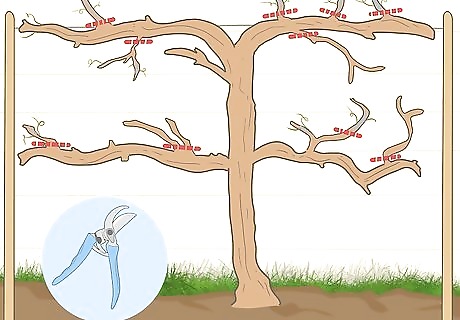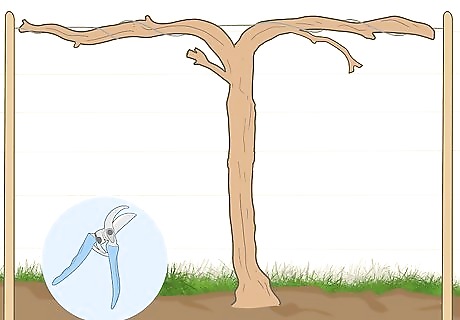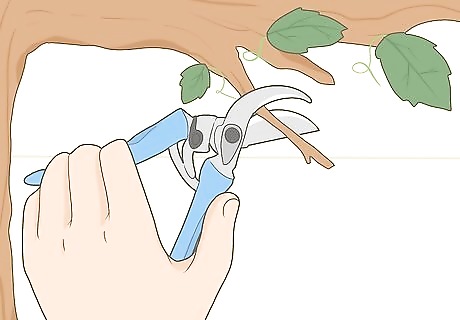
views
X
Research source
With enough patience and dedication, you can get your garden ready for the upcoming harvest season!
Caring for Mature Vines

Prune your vines in late winter or very early spring. Although it may be tempting to prune your plants at the very end of your harvest, give your crops time to stop bearing fruit completely. While you can harvest in the beginning of winter, try waiting until your grape plants are completely barren. If you prune too early, you might end up with too many canes emerging from your plant. For instance, if you live in the Northern hemisphere, February is the best time to prune your grape vines. While pruning can be a time-consuming task, you only need pruning shears or loppers to get the job done. If you prune your vines in very early spring, do so before the buds begin to swell and definitely before the grapes are growing. Grape vines can also be pruned in the summer, once growing, to let in more light to reach the fruit—this helps promote healthier and more nutrient-dense fruit and will help prevent fungal disease, which thrives in more moist conditions.Did you know? Different parts of grape plants have specific names and labels. Canes are thin wooden branches that grow from the cordon, which is the thicker trunk that runs along the trellis wires. All canes have multiple fruit buds, which eventually grow into grape plants. When canes are cut down to only have 1-2 buds, they’re known as spurs.

Use loppers or pruning shears to cut off any canes beneath the trellis wires. Look along the base trunk of the grape plant for any stray canes growing, otherwise known as suckers. Put on a pair of gardening gloves, then trim away these canes completely, or they may overgrow and tangle with the fruit-bearing parts of the plant. All of the fruit-bearing canes need to be attached to the cordon, instead of the lower trunk.

Untangle the grape vines so you can keep track of your pruning. With your gardening gloves on, search along the cordon for any tangled or twisted canes. With careful, prying motions, loosen and separate these canes from one another. If your canes aren’t tangled or twisted, you can disregard this.

Cut off any diseased or damaged canes from the trunk. Examine the grape plant for any shriveled, splintering, or otherwise damaged canes. Use your loppers or pruning shears to completely remove these sections from the cordon. Weakened or dying branches won’t be able to yield fruit in the future, so they’ll just clutter up your branches.
Cutting Away the Canes

Snip away any canes that grew grapes in the previous year. Search for any branching areas that are covered with gray, peeling bark. Even if these canes are still intact, remove them completely with a pair of pruning shears or loppers. Over time, you can see younger canes with red-bronze bark growing back to replace the older canes. In order to keep your grape crop as fresh as possible, you need to use fresh, young canes.

Select 4 sturdy canes to bear new fruit or serve as renewal spurs. Look around your plant for 2 canes that are especially sturdy, and have a diameter matching your pinky finger. Check that these canes have at least 8-10 buds on them, as they will be tied to the trellis and serve as the new cordon. Additionally, choose 2 canes to serve as your renewal spurs, which will grow new canes in the next growing season. These short, trimmed sections are known as renewal spurs. They’ll produce new, fruit-bearing canes the following season.

Tie 2 healthy canes to the trellis wire. Cut 2 long lengths of twine and loop them around both the cane and trellis. Use a single overhand or double half hitch knot to secure the grapevine along a straight, consistent path. Use as many pieces of twine as you need to attach the cane fully to the surrounding trellis. There’s no right or wrong way to secure your grape plants. You can also use a Granny or Miller’s knot, if you’d like! You want your fruit to grow in an even, organized fashion.

Prune back 2 canes until they only have 1-2 buds. Take your pruning shears or loppers and find the 2 sturdy canes that you chose beforehand. Carefully trim each cane down to 1 or 2 buds, so the entire spur is only a few inches or centimeters long. Don’t worry about these spurs for the rest of the growing season. Make sure that your renewal spurs are on opposite sides of the base trunk, so your grape plant looks balanced.

Cut off any remaining canes attached to the grape vine. Once you’ve tied your new cordon to the grape trellis, use your pruning shears or loppers to remove any old canes that are growing from the plant. Don’t be alarmed if you need to trim off a lot of canes—this is all part of the process! You want your plant to be uncluttered so it’s ready to grow new fruit.
Trimming Your Plant into Spurs

Cut off any fruiting wood from the vine. Look around your grape plant for any old canes that yielded grapes in the past growing season. Specifically, use pruning shears or loppers to cut away any branches with gray, shedding bark, and remove them completely from the plant. If the canes are new and didn’t produce any fruit in the last growing season, you don’t need to prune them. Pruning away old branches helps to make your crops higher quality in the next growing season. As you work, be on the lookout for any dead or splintering canes

Trim around 14 canes into spurs with 2-4 buds. Examine your cordon for young, healthy-looking canes. Using your pruning shears or loppers, trim down these canes until they only have 1-2 buds total. As you prune your canes down, try to keep your spurs about 3 to 4 in (7.6 to 10.2 cm) apart on the cordon. You don’t want your spurs to be too close or too far apart, as this could lower the quality of your grapes as they grow in.

Arrange your renewal spurs by pruning 2 healthy canes down to 1 bud. Find 2 healthy canes growing out of the base trunk, then prune them down to a single bud. Before trimming anything, check that the canes are opposite of one another, so your grape plant appears balanced. Your renewal spurs help you to plan ahead for next year’s crop.


















![Kia Sonet Compact SUV to Launch in India Today: Watch it Live Here [Video]](https://cdn.rawisda.com/news/90/eb/76/90eb7699f91f82cb9d217ba52d313a8a-s.jpg)
Comments
0 comment